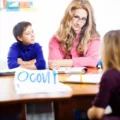What is Social-Emotional Learning?
Social-emotional learning (SEL) refers to the process through which children and adults acquire and apply the knowledge, skills, and attitudes to develop healthy identities, manage emotions, achieve personal and collective goals, feel and show empathy for others, establish and maintain supportive relationships, and make responsible and caring decisions.
4 Key SEL Skills
- Self-awareness – Identifying emotions, recognizing strengths and needs, developing a growth mindset.
- Self-management – Impulse control, stress management, self-discipline, goal setting.
- Social awareness – Perspective taking, empathy, appreciating diversity.
- Relationship skills – Communication, social engagement, relationship building, teamwork.
SEL Activities for Children
Here are some ways to promote SEL skills in children:
- Feelings charades – Act out various emotions
- Kindness notes – Write positive notes to classmates
- Gratitude journal – List things they are thankful for
- Calm space – Create a relaxing environment for self-regulation
The Benefits of SEL
Research shows SEL leads to many benefits for students:
- Better academic performance
- Improved behavior and classroom climate
- Enhanced social skills and relationships
- Reduced emotional distress
Incorporating SEL strategies fosters well-rounded development and life success.
SEL FAQs
What are some SEL best practices?
Best practices include teaching SEL skills explicitly, integrating SEL into all areas of instruction, using strength-based language, providing SEL coaching, and offering ongoing professional development for staff.
How can parents promote SEL at home?
Parents can model SEL skills, use emotion coaching during challenging moments, establish routines and responsibilities to build executive functioning, explicitly teach skills like emotional regulation and conflict resolution, promote service learning and volunteering experiences, and foster healthy social connections.
How long does it take to see results from SEL programs?
Research shows SEL interventions often lead to improvement academically, socially and emotionally within one school year. However, consistent, high-quality SEL implementation over multiple years maximizes benefits.
What are signs that a child struggles with SEL competence?
Signs may include difficulty identifying and managing emotions, lack of impulse control, failure to consider others’ perspectives, inability to resolve interpersonal problems, disengagement or hostility towards peers or family members, or persistent emotional distress.
Who can support SEL implementation in schools?
Principals, teachers, school counselors, school social workers and psychologists, parents, students, and community partners all play important roles in effective SEL programming in schools.









